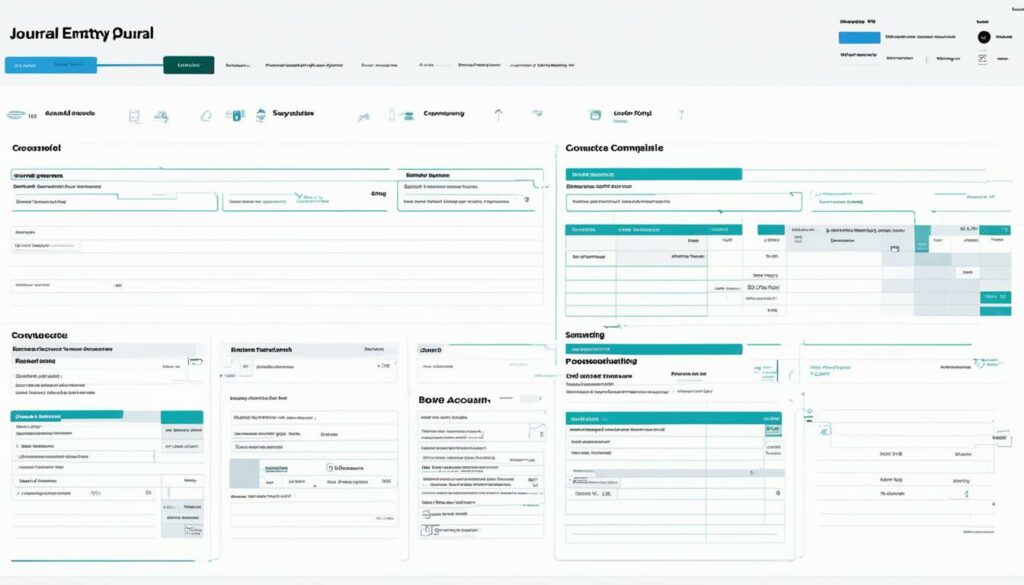Journal entry is a fundamental concept in ecommerce accounting that involves recording and documenting financial transactions. It is an essential process that ensures accurate and complete financial reporting, enabling businesses to track their financial performance and make informed decisions. Journal entries follow the double-entry system, where each transaction is recorded in two accounts, with a debit and credit side, to maintain balance in the general ledger.
By journalizing transactions, businesses create a trail of financial records that can be used for bookkeeping, preparing financial statements, and analyzing financial performance. Journal entries provide detailed information about the accounts affected, the amounts debited and credited, and the dates of the transactions. This information serves as the foundation for generating reports and making strategic financial decisions.
Key Takeaways:
- Journal entry is an important process in ecommerce accounting for recording financial transactions.
- The double-entry system is used to maintain balance in the general ledger.
- Journal entries provide the basis for bookkeeping, financial statements, and financial analysis.
- Accurate journal entries are crucial for tracking financial performance and making informed business decisions.
- Utilizing accounting software can streamline the journal entry process and improve efficiency.
The Importance of Journal Entry in Ecommerce Accounting
Journal entries are a critical component of ecommerce accounting, as they play a pivotal role in maintaining accurate and complete financial records. By carefully recording financial transactions, journal entries provide a solid foundation for preparing essential financial statements such as the balance sheet, income statement, and cash flow statement.
Financial statements offer invaluable insights into a business’s financial health and performance. They allow stakeholders to assess profitability, analyze trends, and make informed decisions. Without accurate and comprehensive journal entries, these financial statements would lack the reliability and integrity necessary for effective financial analysis.
Moreover, journal entries are essential for tracking financial performance over time. By keeping a detailed record of transactions, ecommerce businesses can identify patterns, trends, and areas for improvement. This data-driven approach enables companies to make strategic adjustments, optimize operations, and achieve sustainable growth.
Furthermore, accurate and complete journal entries are crucial for ensuring compliance with reporting requirements and regulatory standards. By maintaining meticulous records, ecommerce businesses can demonstrate transparency and accountability, mitigating any potential legal or financial risks.
Image:

“Accurate and comprehensive journal entries are fundamental for maintaining the integrity of financial statements and tracking financial performance.” – [Insert Real Name], Finance Manager at [Company Name]
Tracking Financial Trends and Making Informed Decisions
By diligently recording financial transactions, journal entries provide valuable data for tracking financial trends. Ecommerce businesses can analyze these trends to gain insights into customer behavior, product performance, and market demand. This information is instrumental in making data-driven decisions related to pricing, marketing strategies, and inventory management.
Ensuring Accurate Financial Records and Audit Trail
Accurate journal entries contribute to the creation of reliable financial records and an audit trail. Detailed documentation of transactions facilitates internal and external audits, ensuring compliance with accounting standards and providing transparency for stakeholders.
Improving Efficiency and Streamlining Accounting Processes
By implementing efficient accounting processes and utilizing accounting software, ecommerce businesses can enhance the accuracy and efficiency of journal entry procedures. Automation reduces the risk of human error, streamlines data entry, and frees up valuable time for more strategic financial analysis.
Strategies to Improve Journal Entry in Ecommerce Accounting
Improving journal entry processes in ecommerce accounting is crucial for maintaining accurate financial records and ensuring efficient financial reporting. By implementing the following strategies, businesses can streamline their journal entry practices and enhance overall accounting efficiency.
Create Efficient Processes
Developing efficient processes is key to improving journal entry practices. Start by clearly defining responsibilities and workflows for journal entry preparation, review, and approval. Establish standardized templates and guidelines to ensure consistency and accuracy in recording transactions. Regularly evaluate and optimize these processes to identify any bottlenecks or inefficiencies.
Utilize Accounting Software
Accounting software can significantly enhance journal entry management and automation. Choose a robust accounting software that allows for seamless integration with other financial systems. These tools offer features such as predefined journal entry templates, automated transaction recording, and real-time reporting capabilities, enabling faster and more accurate data entry.
Implement Automation
Automation plays a vital role in improving the accuracy and efficiency of journal entry processes. By leveraging automation tools, businesses can reduce the risk of manual errors and save time on repetitive data entry tasks. Implement automation for tasks such as data extraction from source documents, journal entry creation, and reconciliation with bank statements. This not only increases accuracy but also frees up valuable resources for more strategic financial analysis.
Establish Segregation of Duties
Segregation of duties is a crucial internal control measure to prevent fraud and unauthorized transactions. By separating responsibilities across different individuals or departments, businesses can ensure that no single person has complete control over the entire journal entry process. This segregation reduces the risk of errors, enhances accountability, and provides an additional layer of protection for financial data.
“Improving journal entry processes through efficient processes, accounting software utilization, automation, and segregation of duties can enhance financial accuracy and efficiency.” – [Author Name]

By implementing these strategies, ecommerce businesses can enhance their journal entry practices, making them more accurate, efficient, and compliant. Regularly reviewing and optimizing accounting processes is essential to adapt to changing business needs and ensure continued success in financial management.
Customer Behavior and Journal Entry in Ecommerce
Customer behavior plays a crucial role in ecommerce, and journal entries provide valuable insights into customer preferences and purchasing patterns. By tracking financial transactions through journal entries, ecommerce businesses can gain a deeper understanding of customer behavior and make data-driven decisions to drive revenue growth.
One key aspect that journal entries help to track is revenue recognition. By accurately recording sales transactions in the journal entries, businesses can ensure proper recognition of revenue in their financial statements. This is essential for maintaining accurate financial records and complying with accounting standards.
Additionally, journal entries help identify sales trends and patterns. By analyzing the journal entries over a period of time, businesses can spot trends such as seasonal demand, popular products, or customer preferences. This information can be used to make informed decisions regarding inventory management, pricing strategies, and marketing campaigns.
Data-Driven Decision Making
Journal entries provide a wealth of data that can be leveraged for data-driven decision making in ecommerce. By analyzing customer behavior patterns and sales trends, businesses can optimize their pricing strategies, develop targeted marketing campaigns, and identify opportunities for product innovation.
Understanding the impact of customer behavior on financial transactions allows ecommerce businesses to tailor their strategies and offerings to meet customer preferences and maximize revenue potential.
For example, let’s consider a fashion retailer that notices a surge in sales for certain apparel items during specific times of the year. By analyzing the journal entries, they can identify the seasonal demand patterns and adjust their inventory accordingly. This helps to minimize stockouts during peak seasons and maximize revenue opportunities.
Furthermore, journal entries enable businesses to track the success of marketing initiatives and promotional campaigns. By linking sales transactions to specific marketing efforts, businesses can measure the effectiveness of their marketing strategies and optimize future campaigns accordingly.
In summary, journal entries provide valuable insights into customer behavior, revenue recognition, and sales trends in ecommerce. By leveraging this data, businesses can make informed decisions to enhance customer experiences, optimize pricing strategies, and drive revenue growth.
Journal Entry in Relation to Other Accounting Metrics
When it comes to financial analysis in ecommerce accounting, journal entry plays a vital role in providing the underlying data for various accounting metrics. These metrics, including the balance sheet, income statement, and cash flow statement, are essential for assessing a business’s financial health and performance.
The balance sheet, also known as the statement of financial position, showcases the assets, liabilities, and equity of a business at a specific point in time. It provides a snapshot of the company’s financial position, highlighting its resources, obligations, and ownership. Journal entries form the basis for the figures and accounts reported on the balance sheet, ensuring its accuracy and reliability.
The income statement, also referred to as the profit and loss statement, reveals a business’s revenues, expenses, gains, and losses over a specific period. It showcases the profitability of the company by subtracting the expenses and losses from the revenues and gains. Journal entries help populate the income statement with the necessary financial data, enabling analysis of revenue generation, cost management, and overall financial performance.
The cash flow statement focuses on the inflows and outflows of cash within a business during a specific period. It classifies the cash movements into operating, investing, and financing activities, providing insights into a company’s liquidity and cash management. Journal entries contribute to the accurate calculation of cash flows, ensuring transparency in tracking the cash generated and used by the business.
By maintaining accurate journal entries, businesses can ensure the integrity and reliability of these accounting metrics. Journal entries provide the necessary information for a comprehensive financial analysis, enabling informed decision-making, trend identification, and performance evaluation.

Challenges and Considerations in Journal Entry for Ecommerce Accounting
When it comes to journal entry in ecommerce accounting, there are several challenges and considerations that businesses need to address. One of the key challenges is accuracy. Ensuring that journal entries are recorded correctly is essential for maintaining reliable financial records and avoiding misinterpretation of financial performance. Any errors in the journal entry process can have significant repercussions.
Another important consideration is documentation. Proper documentation of journal entries is crucial for transparency and accountability. Maintaining detailed records of the date, accounts affected, and debit and credit amounts helps in tracking and verifying the accuracy of the entries. Documentation also plays a crucial role during audits and ensures compliance with accounting standards and reporting requirements.
In order to establish a robust journal entry process, businesses must also focus on creating an organized audit trail. An audit trail provides a clear path of the financial transactions and helps in tracing back the origin of journal entries. This helps in identifying any discrepancies and ensuring the integrity of the financial data.
Lastly, compliance with accounting principles and regulations is of utmost importance. Ecommerce businesses should ensure that their journal entry processes adhere to the relevant accounting standards and reporting requirements. This includes proper classification of transactions, accurate measurement of financial information, and appropriate disclosure of financial data.
FAQ
What is a journal entry in ecommerce accounting?
A journal entry is a record of financial transactions that ensures accurate and complete financial reporting. It includes the date, accounts affected, and debit and credit amounts.
Why is journal entry important in ecommerce accounting?
Journal entries are important as they enable accurate and complete financial records, provide the basis for preparing financial statements, and track financial performance.
How can I improve journal entry processes in ecommerce accounting?
To improve journal entry processes, you can implement efficient processes, utilize accounting software for automation, and establish proper internal controls such as segregation of duties.
How can journal entries in ecommerce accounting provide insights into customer behavior?
Journal entries can track revenue recognition, identify sales trends, and help businesses understand customer preferences, purchasing behavior, and seasonal demand.
How are journal entries related to other accounting metrics?
Journal entries provide the underlying data for metrics such as the balance sheet, income statement, and cash flow statement, allowing for comprehensive financial analysis.
What are the challenges and considerations in journal entry for ecommerce accounting?
Challenges include accuracy, proper documentation, organization of the audit trail, and compliance with accounting principles and regulations.
